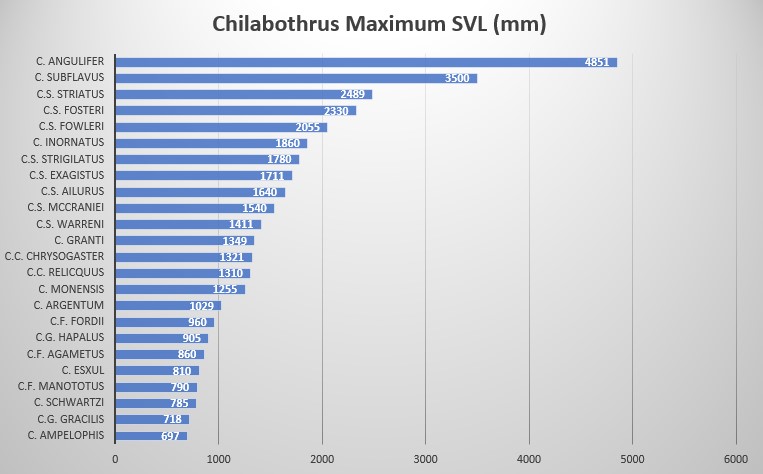Scientific Name
Chilabothrus exsul

Described and named by Maurice Graham Netting (1904-1996) and Coleman Jett Goin (1911-1986). Netting was an American herpetologist who served as the Curator and then Director of the Carnegie Museum of Natural History. Goin was at the time associated with the University of Florida and later became a Zoology Professor. Later he wrote (together with Olive B. Goin and George R. Zug) the famous book, An Introduction to Herpetology.
Holotype
Carnegie Museum of Natural History, Pittsburgh (CM) no. 21408. Male collected vicinity Blackrock, on the east coast of Great Abaco on February 6, 1942 by Arthur C. Twomey.
Type Locality
On the east coast of Great Abaco (near Blackrock) in the Bahama Islands.
Subspecies
None.
Synonyms
- Epicrates exsul [72] [73] [74] [75] [76]
- Epicrates exsul : 259
- Epicrates exsul
- Epicrates exsul [121] [122]
- Epicrates exsul
- Epicrates exsul [13]
- Epicrates exsul
- Epicrates exsul
- Epicrates exsul
- Epicrates exsul : 19
- Epicrates exsul
- Epicrates exsul Tipton, 2005: 44
- Chilabothrus exsul
- Epicrates exsul
- Epicrates exsul : 105 [106]
- Chilabothrus exsul : 10
- Chilabothrus exsul : 282
- Chilabothrus exsul : 37
The name exsul is from the Latin for "banished person, wanderer, an exile".
Common Name
Abaco Island Boa, Abaco Islands Boa, North Bahamas Boa.
Description and taxonomic remarks
Chilabothrus exsul is a moderate sized boa of the genus Chilabothrus. The body is slender, laterally compressed and the head is distinct from the neck. The head in males measures up to 566 mm and females up to 810 mm Snout-vent Length (SVL). Males measure 243-251 ventral scales and females measure 236-246. Subcaudals measure 72-75 in males, 69-72 in females, ventrals+subcaudals measure 316-326 in males, 305-317 in females, dorsal scale rows at neck 28-33, dorsal scale rows at midbody 35-40, pre-intersupraoculars are 5, inter-supraoculars are 2, post-intersupraoculars are 4.

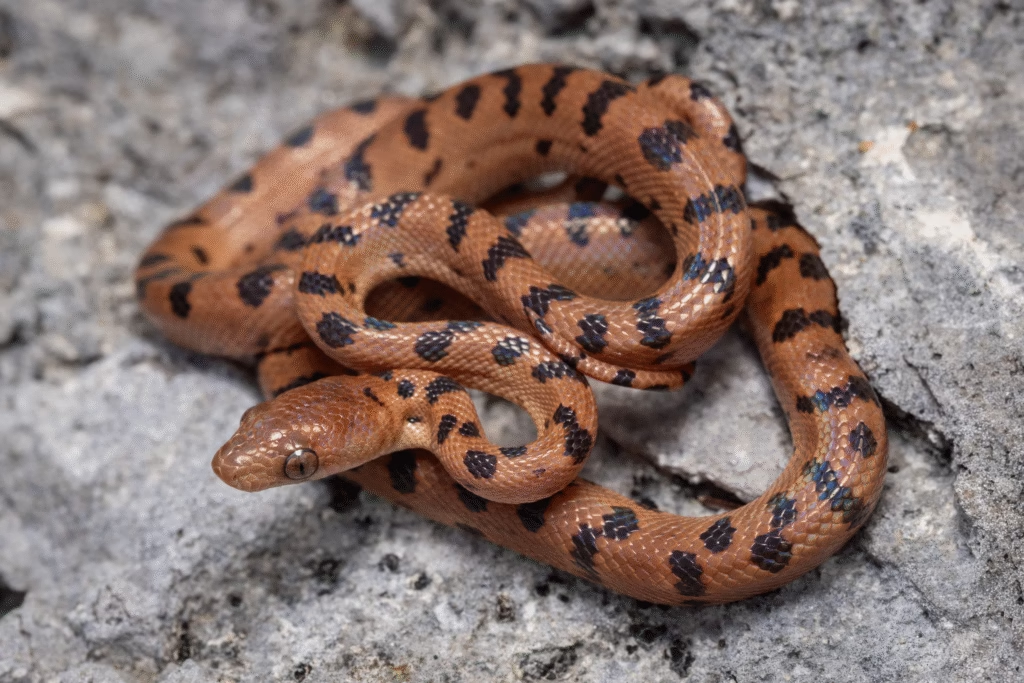
Sheplan and Schwartz note distinct differences in pholidosis and body size of a single animal from Little Abaco, compared to the animals from Great Abaco they studied . Photographic evidence from a website shows a snake most likely exceeding the measurements given here. The author states that this specimen had been photographed at Tilloo Cay, Abaco in 2008. Unfortunately, the snake can not be identified as Abaco Island Boa based on the pictures and the length can not be estimated with certainty. However, if this is indeed an Abaco Island Boa, it most likely represents the largest specimen known to date (Link to website). The Abaco Island Boa can most easily be distinguished from the similar Turks and Caicos boa by the absence of the postorbital stripe.
Schwartz is of the opinion E. exsul (then) is remarkably like E. gracilis (then) of Hispaniola and may represent a long separated Hispaniolan element on the Little Bahama Bank. It is the only native Bahamian reptile or amphibian whose range is limited to the Little Bank. C. exul, along with Cyclura, T. canus, Alsophis and Chrysemys were considered Old “Great Bank” fauana. (Schwartz 1968, 260).
Sheplan & Schwartz (1974), Tolson (1987) and Kluge (1989) all agree on the placement of all the species of the genus except C. exsul. It does look like C. exsul is derived from a common ancestor with C. strigilatus. A new analysis is currently being conducted on the genus to confirm this. The results will not be available until some time in 2021 (Reynolds pers. comm.).
Of particular interest is the following by Sheplan and Schwartz (1974) when describing the boas from Little Abaco and Great Abaco:
"Since there is only one specimen available from Little Abaco, it is impossible to compare the populations of E. exsul on Little and Great Abaco. However, the following data are of interest. The Little Abaco specimen (CM 45450) is the largest male exsul (the larger of the two Great Abaco males has a 525 mm snout-vent length), it has the only pre-intersupraocular scale count of 3 (all other snakes have 5 scales in this position), and has the only post-intersupraocular count of 3 (4 or 5 on Great Abaco). The Little Abaco male also sets the low parameters of anterior and posterior dorsal scale rows (28 on neck, 19 before vent). The scale differences between this snake and those from Great Abaco suggest that some differentiation has taken place." To our knowledge this difference has not been pursued and resolved.

* Source

Remarks: Note the prominent postorbital stripe on the Turks and Caicos Boa, absent from the Abaco Island Boa. Photos by Jay Wagner (C. exsul) and Tom Crutchfield (C. chrysogaster).
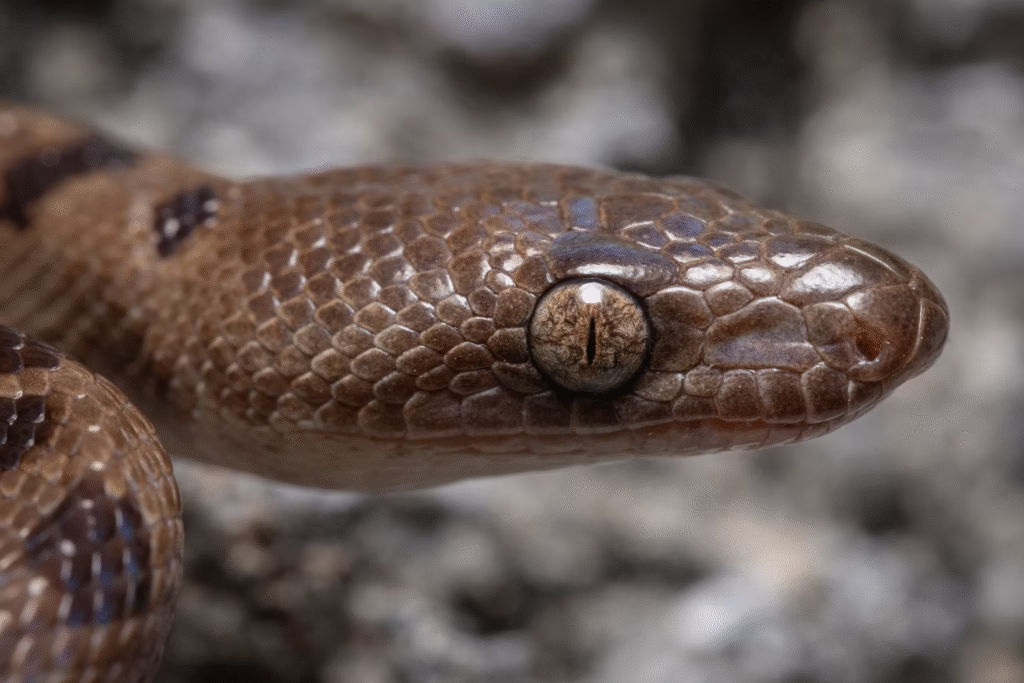
Evolution
Fossil remains of a boa have been found on Abaco. They stem from one individual that had lived in between 4200 – 1000 years before present. The authors of the study considered it to be “Epicrates striatus” using the taxonomic status present for the bahamian boas of the strigilatus group at the time of their writing in 2007 . Researching further they reconsidered their statement and refer to the boa as Chilabothrus cf. exsul. They reason their view as follows: “the adult fossil vertebrae from Sawmill Sink suggest a midsized Chilabothrus (larger than modern C. exsul, but smaller than C. striatus).” . They however seem to exclude the possibility that this boa might have been a smaller (now extinct) form of C. strigilatus. The finding of this specimen poses the question whether there were several Chilabothrus species present on Abaco at the time, or whether C. exsul underwent a size diminishing process over the course of time.
Distribution
Elbow Cay, Green Turtle Cay, Tilloo Cay, Little Abaco Island, Great Abaco Island and , possibly, the eastern end of Grand Bahama . It is unknown whether it is found on the other isles and islands of the Little Bahama Bank.
[intergeo id=”QOwETM”][/intergeo]
Habitat
The northern Bahamas Islands (Grand Bahama, Abaco, New Providence, and North Andros) experience more rainfall and more seasonal and cooler conditions relative to the entire archipelago. Rainfall ranges from 1250 mm to 1500 mm per year . Great Abaco and Little Abaco Islands also include Tilloo Cay, Green Turtle Cay, Treasure Cay, Elbow Cay and Man of War Cay. In addition to the older economy of boat building and fishing, citris farming and tourism have been added to an area of 1350 km². Approximately 10% of the original coppice forest remains intact.
Dr. Twomey’s notes provide the following description of the location where he found the holotype for the subspecies: “At Blackrock, Great Abaco, the original pine forest has been removed, but inland from Cocoplum Creek (about three nautical miles south of Blackrock) large stands of virgin pine forest still occur; here dense undergrowth makes penetration difficult, except along the trails which connect numerous small clearings. February 6 was chilly, with intermittent rain. Three snakes, which had apparently emerged from holes in the coral rocks to warm themselves in the sun, were seen along the margins of two adjacent clearings. One (the type) was collected, but the other two, about the size of the specimen collected, escaped into crevices in the knife-edged, eroded rocks. The entire area was overrun with introduced wild pigs, for which the natives had set snare nets in the numerous runways”.
Netting and Goin mention that the first three specimens were found in a virgin pinewood forest (Pinus caribaea var. bahamensis) with dense undergrowth. The boas had emerged from holes in the coral rocks, along the margins for adjacent clearings. In addition, they report villagers had apparently seen snakes in their gardens. Some pictures found on the website iNaturalist.org, suggest that the boas might be found in large gardens. On Great Abaco they can be found in burned-over pinewoods and cut-over scrub and pine . According to Henderson and Powell, the species is primarily found in coppice (hardwood forest), and occasionally also in pine forest and gardens .

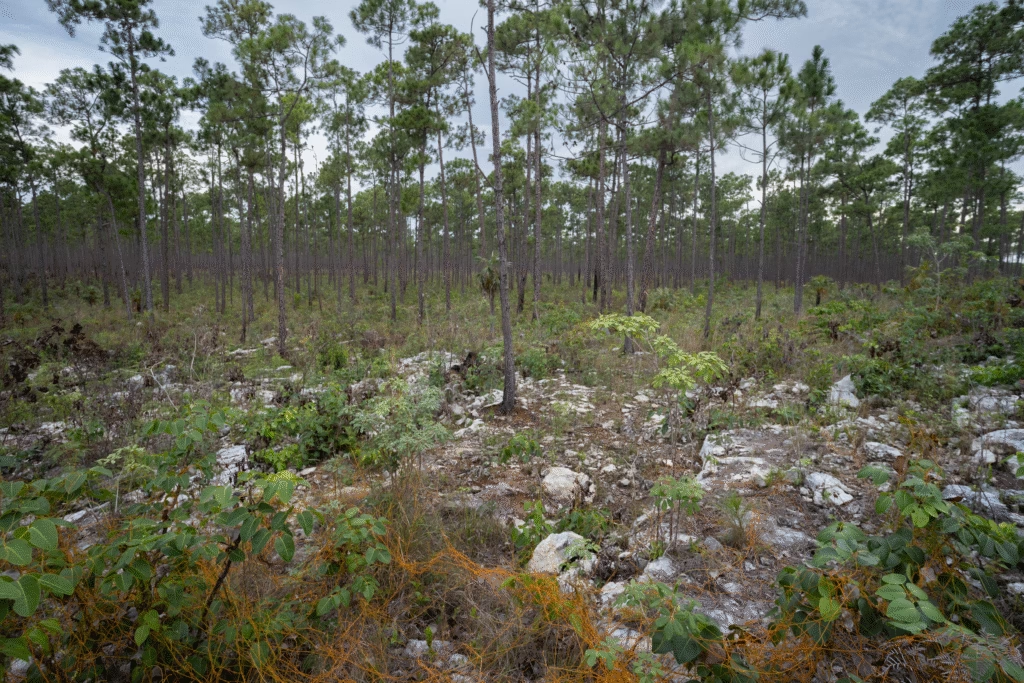
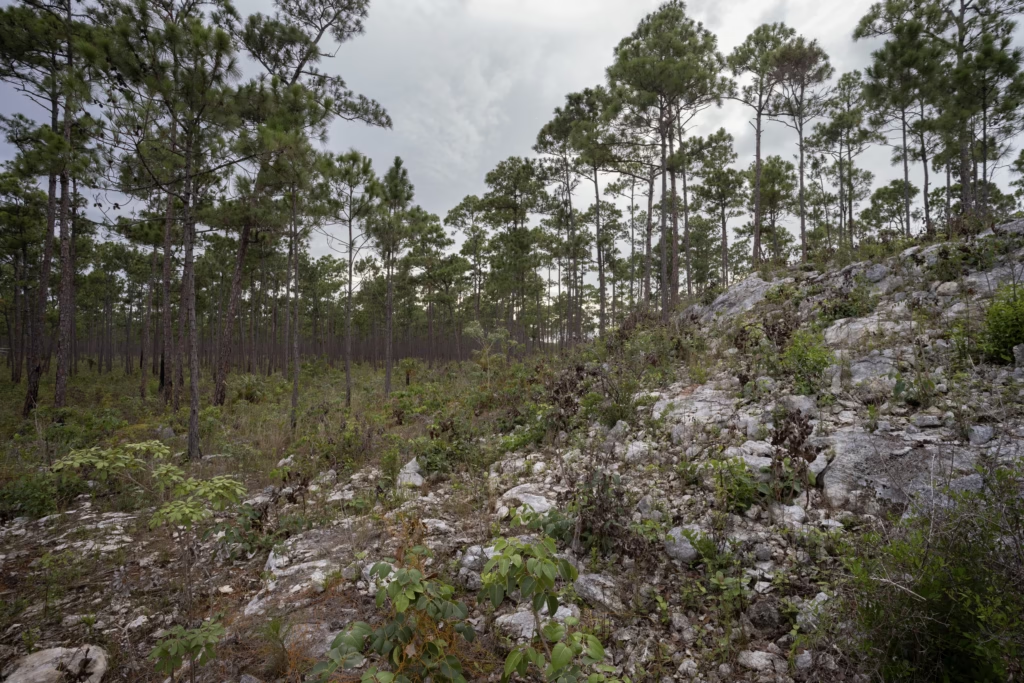
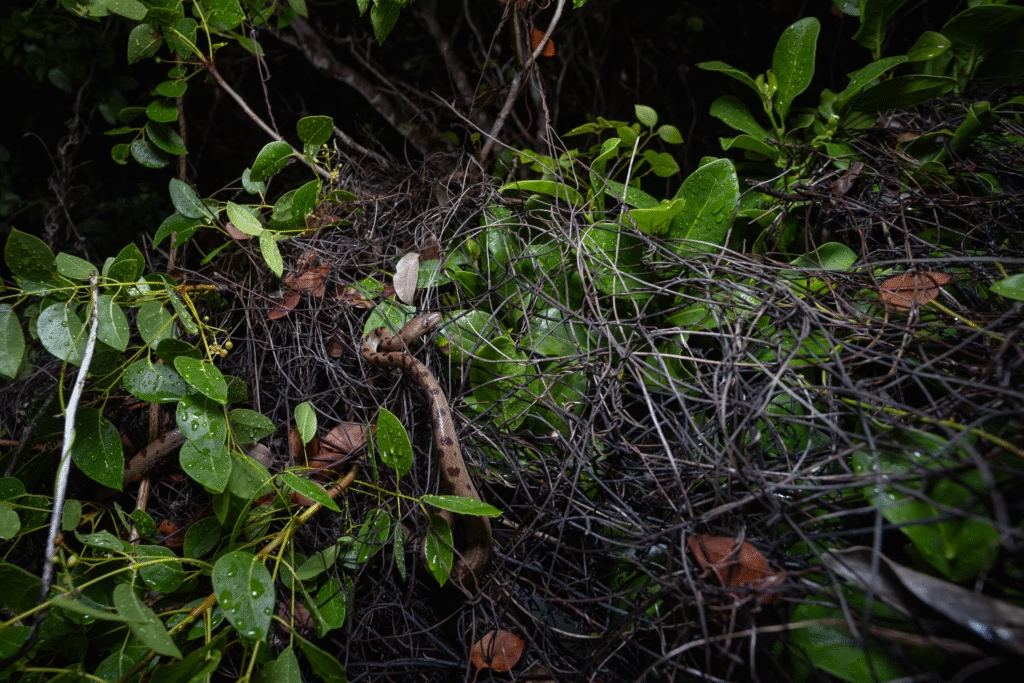
Longevity
The Houston Zoo held a wild caught female for 24 years and 8 month . Currently, several of the remaining animals in captivity are more than 40 years old.
Reproduction
The following reproduction data for zoos and private collections have been recorded :
1977 FORT bred during 1977.
1978 FORT bred during 1978.
1979 ATLG 0.0.9 born during 1979, 2 did not survive.
1980 FORT bred during 1980.
1981 ATLG 0.0.3 born during 1981.
1990 TOLO 0.0.2 born during 1990.
1991 OKLO 0.0.6 born during 1991.
1995 OKLO 0.0.7 born during 1995.

The only knowledge we have about reproduction of this boa is from captive breedings. Litter size ranges from 2 – 11 young weighing 4.5 g to 7.3 g; SVL is 231 mm to 280 mm. Tolson noted male to male combat has been observed in this boa. He also documented the reproductive longevity of this boa. The Toledo Zoo succeeded in breeding a 15 year old Abaco Island Boa . This remarkable record from 1990 was surpassed by the most recent breeding in which both breeder animals were more than 30 years old. The 2013 breeding by a US collector followed the standard procedure for Chilabothrus with winter cooling, introduction of males to females and misting of the enclosure (Wagner pers. comm.).
In the wild two gravid females have been observed beneath debris at the high tide line on Little Abaco, presumably thermoregulating .

Neonate weights for a litter of 9 babies born at the Toledo Zoological Gardens ranged from 4.5 g – 7.3 g; SVL measured 231 mm-280 mm .
Diet
Relatively little is known about the diet or preying strategies of the Abaco Island Boa. Tolson and Henderson assume this boa is an opportunistic feeder preying on lizards, small birds and rodents . Walker claims that the boas are the natural predators of the Abaco Parrot Amazona abaconensis . Reynolds et al. found that the boas are preying on lizards, birds and rodents as adults and on Anolis sp. as juveniles . In captivity, adults feed on rodents while juveniles, like all other Chilabothrus species, (except C. angulifer) prey on anoles.
Captive management and captive population
The Abaco Island Boa was kept in terraria of European and American private breeders and Zoos since the early second half of the last century with several breedings accomplished by private keepers and institutions alike. Interestingly, no detailed breeding record in the form of a journal or magazine article was ever published for this snake species, contrasting the situation in other Chilabothrus species.
As public interest in the boas softened, the Zoos also lost interest in maintaining the boas. Funding priorities, space allocation, animals deemed more important and changes of leadership all contributed to the decline of the boas in both public and private collections. By the late 1990’s all breeding efforts by zoos and private Herpetologists were largely discontinued. The handful of remaining zoo animals found their way to the skilled hands of a private breeder in the U.S.A. who successfully bred the very old adults. At this moment the ex-situ population is on a tipping point; dependent on the success in raising 1.2 young boas, which are siblings from a litter of six, born in September, 2013. Two of the six babies were premature with large yolks attached and, consequently, did not survive (Wagner pers. comm.).
Conservation status, threats and population size in nature
CITES: Appendex II
Bahamas joined CITES on 20 July, 1979; entry into force on 18 September, 1979.
Catalogue of Life: (click here)
The National Center for Biotechnology Information: (click here)
CITES import/export data: (click here)
Bahamas Wild Animals (Protection) Act (1968)
Bahamas Wildlife Conservation and Trade Act (2004).
The 22 July, 2015 IUCN rating of VU is described as follows:
The species is endemic to the Bahamas, within which it has a small distribution on Abaco and Grand Bahama (has an extent of occurrence (EOO) of <13,500 km2). Where major roads cross the species' habitat on these two islands, these are considered the primary threat, defining two locations. Tourism development on tiny offshore cays defines a third location. Through the remainder of the species' range, predation from cats is considered to be the primary threat, defining a fourth location. The species is therefore assessed as Vulnerable under criterion B1 meeting the thresholds based on its small EOO, occurrence at four threat-defined locations, and the inferred continuing decline in the number of mature individuals.
While the Bahamas are generally a well studied region in terms of conservation, this boa species in particular appears understudied. While the islands where this species supposedly occurs have an extant area of app. 13,500 km2, the potential habitat might be much smaller in size.
Detailed population studies are non-existant; nonetheless, the IUCN considers it evident that the population trend is decreasing and consequently lists the species as Vulnerable (VU) . The only research in terms of its conservation is an assessment on road mortality of the boas. Cherokee Road, which was tarmacked in the 1990s and on which traffic volume is increasing causes substantial mortality in the boa population. A study published in 2016 on Abaco determined road mortality due to vehicular traffic was 1.6 boas a week, suggesting those numbers might possibly increase during breeding season. Simple math equates to 6.4 boas a month; within a year that number increases to 76.8 boas killed by road traffic. This type of study should be conducted throughout the Caribbean to determine the effects of vehicular traffic, road mortality numbers and effects on the boa populations.

The article also reviewed the different threats to the population in detail. They came to conclude that among the most substantial threats for survival is predation by feral animals (cats, dogs, pigs, raccoons, rats).
Habitat loss for land development and changed land management is another substantial issue . Worrying also, is the recent report of Rhinella marina, the cane toad on Abaco . Given the detrimental effect this species had on Australian herpetofauna, we sincerely hope that the Bahamas snakes will be less affected by it.
The sword of Damokles hanging over the future of Abaco Island Boas, as well as all Caribbean Wildlife, is climate change. This will change ecosystems in both unpredictable and unprecedented ways. The recent island flooding from the powerful Hurricane Dorian placed much of the island under water. It is unclear how many of the boas, let alone fauna, were lost to this natural disaster.
Steadman and colleagues investigated Abaco Island for fossils to reconstruct the Vertebrate community of Abaco during the ice-age. During late Pleistocene 95 vertebrate taxa (13 fishes, 11 reptiles, 63 birds, 8 mammals) were present on Abaco; 39 species are no longer present. While 17 of the 39 losses are linked to changes during the Pleistocene–Holocene Transition (PHT) (∼15–9 ka) when climate became more warm and moist, habitat changed and sea level rose. The remaining 22 losses likely are related to the presence of humans on Abaco for the past 1,000 years. Thus, the late Holocene arrival of people probably depleted more populations than the dramatic physical and biological changes associated with the PHT . Chilabothrus exsul survived the PHT and the first wave of human caused extinction 1000 years ago.
Unfortunately today, it faces new threats caused by humans. Thus we feel C. exsul is a primary candidate for ex-situ breeding colonies maintained by trusted and responsible entities. The success story of Chilabothrus granti should work as an inspiration to determined professional and private keepers of the species.



Toslon writes, in 1993, “Common in many localities on the Little Bahama Bank, this species in not endangered and commonly bred in several zoos” . How times have changed. We consider C. exsul one of two immediate candidates for the Invisible Ark.
The CIA World Factbook lists the following environmental threats for The Bahamas: coral reef decay; solid waste disposal
The map below illustrates the extent of habitat destruction and alteration due to development and agriculture.


On display in these Zoos
We are unaware of any live Chilabothrus exsul on display in zoo or academic collections .
Awesome Abacos


Further images of Abaco Island boas (link outs)
Adult Abaco Island Boa, image by Sean Giery
Abaco Island Boa, roadkill. Picture by Sean Giery
Abaco Island Boa
Abaco island Boa, adult

Citations
